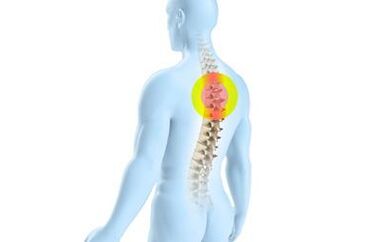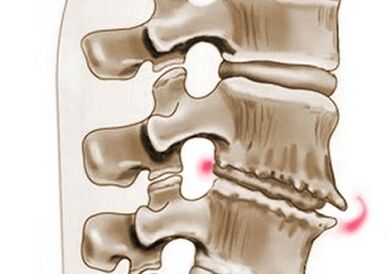Osteochondrosis of the thoracic spine is a rare pathology and the most "insidious" form of osteochondrosis. Due to anatomical features, this part of the spine is rarely subject to degeneration. The twelve vertebrae of the department are very firmly connected to each other and are perfectly protected by a kind of corset of muscles, which significantly limits the range of motion between them. The ribs give additional stiffness to the vertebrae.

The most likely reason for the formation of osteochondrosis of the chest is scoliosis, which is formed even at the school desk. The risk factor for damage to the intervertebral disc can be:
- hereditary factor;
- improper nutrition and overweight;
- work activity associated with limitation of movements;
- exorbitant physical activity;
- age factor and hypothermia;
- instability of the vertebral disc segments;
- smoking and nervous tension;
- bruises, fractures and injuries of the spine are the most favorable factor for the formation of thoracic osteochondrosis.
Signs and symptoms
A hallmark of breast osteochondrosis is pain. It is customary to subdivide it into types:
- Lumbago - dorsago. The manifestation of sharp and sudden pain in the area of the affected vertebral discs. Symptoms of osteochondrosis of the thoracic spine are the result of a prolonged sedentary position, when you have to sit at a table, bent, for a long time. Acute pain (low back pain) occurs when you try to stand up or get up.
- Back pain Increased pain when trying to breathe deeply and when moving the trunk. The back muscles are tight and movement may be limited in any region of the spine.
Visceral manifestations (internal)
With osteochondrosis of the chest, the symptoms are rich in internal (visceral) manifestations.
The defeat of the upper thoracic nerve roots causes pain in the esophagus and pain in the pharynx.
Pressure on the affected area of the spine increases pain. It can be paroxysmal.
Symptoms of osteochondrosis of the thoracic region, manifested by pain in the stomach, indicate damage to the nerve endings of the mid-thoracic region, leading to increased pain when lying on your back for a long time.
Compression of the eighth and ninth spinal roots causes pain in the duodenal region. The sensitivity of the anterior part of the abdominal wall is affected.
Abnormal gastric motility (discharge and peristalsis) is a characteristic symptom of thoracic osteochondrosis.
Result:
- nausea and vomiting;
- acidity;
- pain in the left hypochondrium;
- flatulence;
- diarrhea or constipation.
Duodenal dysfunctions (secretory and motor) lead to:
- nausea and belching;
- in the right upper quadrant there is pain and a feeling of heaviness.
Most often, osteochondrosis of the thoracic region is manifested by symptoms characteristic of other diseases, for example, angina pectoris. At the same time, pain in the heart is noted - cutting, pressing, burning the heart or squeezing the throat.
With laryngospasm, the result of a pathology at the level of the cervical vertebrae, the symptoms develop manifesting themselves:
- shortness of breath and cough;
- wheezing
- difficulty breathing.
In the treatment of thoracic osteochondrosis, the symptoms and manifestations of which are similar to those of pulmonary pathology, it is necessary to precisely establish its participation in the disease of the spine.
Treatment of osteochondrosis of the thoracic spine.
When drawing up a treatment plan that determines how to treat osteochondrosis of the thoracic region, diagnostic data based on an X-ray examination helps. Such an examination gives a clear idea of how to treat thoracic osteochondrosis, because X-ray readings that indicate the proliferation of vertebral bodies and the presence of changes in intervertebral distance (decrease in height) are a characteristic symptom of this disease.
On the basis of the data from the diagnostic examination, the main symptomatology is determined, the clinical diagnosis is clarified, which makes it possible to determine the correct tactics.
Treatment of osteochondrosis of the thoracic spine directly depends on the syndromes, the stage of development and the presence of underlying diseases.
To relieve pain, restore damaged functions of the nerves of the spinal roots, prevent the progression of degenerative changes in the structure of the spine, a conservative method is used, combined with complex step-by-step treatment.
Treatment of thoracic osteochondrosis includes a number of physiotherapeutic procedures:
- inductometry and electrophoresis;
- laser therapy and vacuum therapy;
- sinusoidal and diadynamic modeled currents;
- magnet and pharmacopuncture;
- acupuncture.
Drug therapy:
- diuretic and muscle relaxant vasoregulatory drugs (muscle relaxants and venotonics);
- paravertebral novokoin block.
Physiotherapy
Physiotherapy for thoracic osteochondrosis is the main stage of the recovery process. Strengthens the muscles and mobility of the spine. Exercise for thoracic osteochondrosis helps improve ventilation in those patients in whom deep breathing causes pain.
Gymnastics for osteochondrosis of the thoracic region is effective:
- when the spine is stretched;
- by setting the correct breath.
But we must not forget that gymnastics for thoracic osteochondrosis is effective only when all the causes of the disease are identified and eliminated.
If the prescribed course of treatment has not yielded positive results, then various methods of surgical intervention are used, depending on the pronounced symptoms and the level of destruction.
Cervicothoracic osteochondrosis
Cervicothoracic osteochondrosis is a disease caused by processes (degenerative-dystrophic) that affect the discs of the cervical spine.
The vertebrae located close to each other are not adequately protected by a relatively underdeveloped muscular structure. Even the slightest strain on the neck causes myelopathy.
Main symptoms

Symptoms of cervicothoracic osteochondrosis are manifested:
- disorder of the sensitivity of the muscles of the neck, skin, hands and face;
- headache and dizziness attacks;
- gait instability;
- increased fatigue, impaired vision and hearing.
The pain radiates to the arm, extends from the same shoulder to the tips of the fingers, causes numbness of the skin, even a slight movement of the neck, can cause a sensation of electric current throughout the entire arm.
Myelopathy can cause:
- lung and heart disorders;
- double vision;
- numbness of the tongue
Treatment of exacerbation of the disease.
The use of complex therapy in the treatment of exacerbation of cervicothoracic osteochondrosis makes it possible to obtain a long-lasting positive result. It includes:
- The method of orthopedic correction is the fixation of the neck with the Chance collar, which supports the head, significantly relieves the tension on the cervical vertebrae and contributes to their alignment.
- The method using pharmacopuncture: anti-inflammatory drugs (preferably homeopathic), to relax spasmodic muscles and prevent worsening of root compression.
- Chondroprotectors: to prevent the development of damage to cartilage tissues.
- Medications that help strengthen the disc-ligamentous apparatus of the vertebral discs.
- Acupuncture is used to quickly relieve pain, relieve muscle spasms, and restore function of the spinal nerves. This method is very effective and its use during an exacerbation prevents the progression of the disease for many years.
- Hirudotherapy: treatment with leeches promotes the healing of damaged fibrous rings in the discs, removes edema of the nerve roots and improves blood circulation in the discs of the spine.
- Drug therapy: biogenic stimulants, drugs that improve peripheral circulation, vitamins.
- Massage: to relax spasmodic muscles, restore and strengthen them.
In the final period of treatment, subject to the elimination of muscle spasm and inflammatory processes, are connected: manual therapy, osteopathy, exercise therapy.
Timely treatment of any disease will prevent exacerbations and various complications caused by them.



































